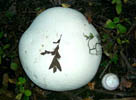Terms discussed: acetylglucosamine (pl. acetylglucosamines), chitosan, glucan (pl. glucans), glucoaminoglycan (pl. glucoaminoglycans), glucosamine (pl. glucosamines)
In the wild world where multi-cellular creatures first began to evolve, plants were the first to break away from the herd and start to become something distinct. Fungi and animals seem to have continued together for a while before diverging into their present distinct states. One consequence of this is that although fungi have cell walls, like plants, so they don't need a skeleton to support themselves, their cell walls are made of chitins, the same class of compounds that compose the exoskeletons of insects and crustaceans.
Back to top
Chitins are polymers of glucosamine, with an acetyl group attached to a variable number of the individual glucosamine molecules (making them acetylglucosamine). A polymer composed totally of acetylglucosamine is called chitin, and one composed totally of glucosamine is called chitosan. These polymers and those made up of a mixture of glucosamine and acetylglucosamine are known collectively as glucoaminoglycans.
Back to top











